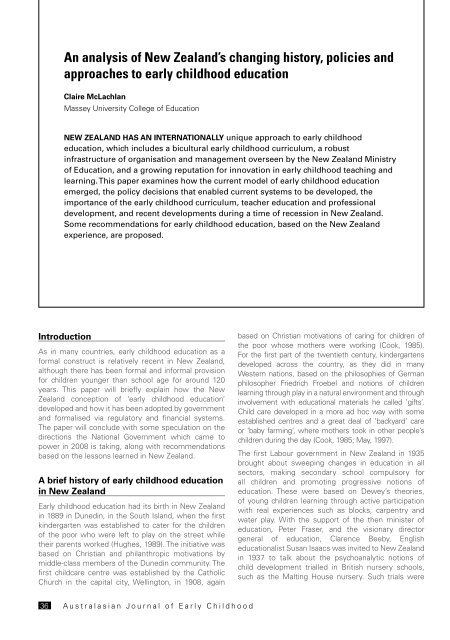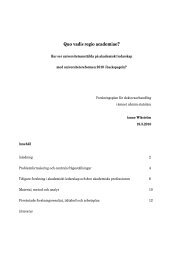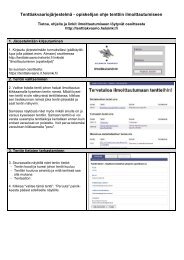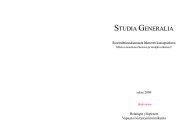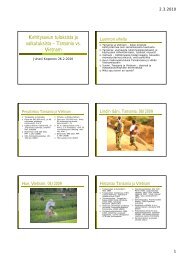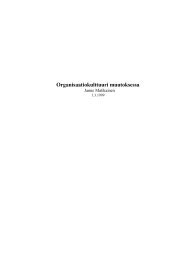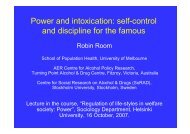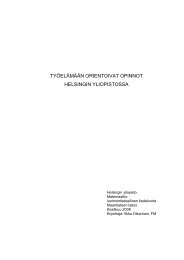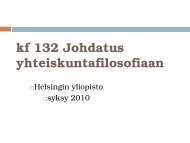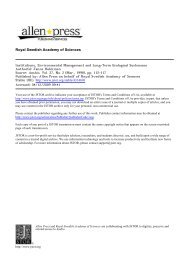An analysis <strong>of</strong> New Zealand’s changing history, policies andapproaches to early childhood educationClaire McLachlanMassey University College <strong>of</strong> EducationNew Zealand has an internationally unique approach to early childhoodeducation, which includes a bicultural early childhood curriculum, a robustinfrastructure <strong>of</strong> organisation and management overseen by the New Zealand Ministry<strong>of</strong> Education, and a growing reputation for innovation in early childhood teaching andlearning. This paper examines how the current model <strong>of</strong> early childhood educationemerged, the policy decisions that enabled current systems to be developed, theimportance <strong>of</strong> the early childhood curriculum, teacher education and pr<strong>of</strong>essionaldevelopment, and recent developments during a time <strong>of</strong> recession in New Zealand.Some recommendations for early childhood education, based on the New Zealandexperience, are proposed.IntroductionAs in many countries, early childhood education as aformal construct is relatively recent in New Zealand,although there has been formal and informal provisionfor children younger than school age for around 120years. This paper will briefly explain how the NewZealand conception <strong>of</strong> ‘early childhood education’developed and how it has been adopted by governmentand formalised via regulatory and financial systems.The paper will conclude with some speculation on thedirections the National Government which came topower in 2008 is taking, along with recommendationsbased on the lessons learned in New Zealand.A brief history <strong>of</strong> early childhood educationin New Zealand<strong>Early</strong> childhood education had its birth in New Zealandin 1889 in Dunedin, in the South Island, when the firstkindergarten was established to cater for the children<strong>of</strong> the poor who were left to play on the street whiletheir parents worked (Hughes, 1989). The initiative wasbased on Christian and philanthropic motivations bymiddle-class members <strong>of</strong> the Dunedin community. Thefirst childcare centre was established by the CatholicChurch in the capital city, Wellington, in 1908, againbased on Christian motivations <strong>of</strong> caring for children <strong>of</strong>the poor whose mothers were working (Cook, 1985).For the first part <strong>of</strong> the twentieth century, kindergartensdeveloped across the country, as they did in manyWestern nations, based on the philosophies <strong>of</strong> Germanphilosopher Friedrich Froebel and notions <strong>of</strong> childrenlearning through play in a natural environment and throughinvolvement with educational materials he called ’gifts’.Child care developed in a more ad hoc way with someestablished centres and a great deal <strong>of</strong> ‘backyard’ careor ‘baby farming’, where mothers took in other people’schildren during the day (Cook, 1985; May, 1997).The first Labour government in New Zealand in 1935brought about sweeping changes in education in allsectors, making secondary school compulsory forall children and promoting progressive notions <strong>of</strong>education. These were based on Dewey’s theories,<strong>of</strong> young children learning through active participationwith real experiences such as blocks, carpentry andwater play. With the support <strong>of</strong> the then minister <strong>of</strong>education, Peter Fraser, and the visionary directorgeneral <strong>of</strong> education, Clarence Beeby, Englisheducationalist Susan Isaacs was invited to New Zealandin 1937 to talk about the psychoanalytic notions <strong>of</strong>child development trialled in British nursery schools,such as the Malting House nursery. Such trials were36A u s t r a l a s i a n J o u r n a l o f E a r l y C h i l d h o o d
ased on Freudian theories <strong>of</strong> the ‘natural child’ and theimportance <strong>of</strong> children’s ‘free play’ in building healthypsychological development. With encouragementfrom government, the first nursery play centres wereestablished in New Zealand, run initially by middle-classparent cooperatives throughout New Zealand, but alsobeing adopted by working-class families (Stover, 2011).Under the leadership <strong>of</strong> Beeby, ideas for post-wareducation were circulated in a publication in 1944entitled Education for today and tomorrow (Mason,1944, in Stover, 2011). This document posed challengingquestions about ‘preschool education’, including theneed for all-day nursery schools, collaboration betweenservices, and teacher education. The appointment <strong>of</strong> a firsteversupervisor <strong>of</strong> pre-school services in 1946 signalleda change in kindergarten practices, whereby teacherswere encouraged to let children ‘be free’ by giving themchoices, to minimise routines, and to encourage ‘free play’(May, 1997). Understandings <strong>of</strong> free play were publishedin a number <strong>of</strong> influential playcentre publications, whichwere used by the kindergarten training colleges forhelping student teachers to understand how to promote‘free play’ (Stover, 2011). In her analysis <strong>of</strong> the history <strong>of</strong>the role <strong>of</strong> play in New Zealand, Stover (2011) argues that‘free play’ was in its heyday across the diverse servicesfor young children from the 1950s to 1980s, althoughnot always well-understood or accepted by families andthe wider education community; and other services withdistinctly different philosophies emerged during thistime. In addition to the already-established kindergartens,childcare centres and playcentres, playgroups, Montessoripreschools, Steiner kindergartens, Māori language totalimmersion centres (Kohanga Reo), and more recentlyvarious Pacific Island language nests emerged, creating adiverse and complex early childhood sector. As Loveridgeand McLachlan have argued:<strong>Early</strong> childhood education in New Zealand is theresult <strong>of</strong> historical, cultural and political factors,as well as a response to dominant and emergingtheories <strong>of</strong> how children learn. It has variouslypromoted social regulation, philanthropic concernfor children, support for mothers, equality forwomen, cultural assimilation and survival, andeconomic outcomes. Services have emerged inresponse to these discourses and the sector hasbecome diverse and complex (2009, p. 22).Policy reform in the 1980sNew Zealand faced its next major overhaul <strong>of</strong> educationin the mid-’80s, following the election <strong>of</strong> the fourthLabour government, under the leadership <strong>of</strong> PrimeMinister David Lange. Labour took power in the face <strong>of</strong>a fiscal and financial crisis, which precipitated a number<strong>of</strong> major reforms, including many in education. Onewas the decision to move the governance <strong>of</strong> childcarecentres to the Department <strong>of</strong> Education (now Ministry<strong>of</strong> Education) from the Department <strong>of</strong> Social Welfare,where it had previously resided, to join the kindergartenassociations, which had traditionally resided in theDepartment <strong>of</strong> Education, under the governance <strong>of</strong> theState Sector Act and with full funding <strong>of</strong> kindergartensby the state. This decision was prompted by a number<strong>of</strong> serious complaints about the quality <strong>of</strong> child careand prompted a reconceptualisation <strong>of</strong> how all earlychildhood services should be funded and regulated(May, 1997). This reorganisation meant that both childcare and education were funded from Vote Educationfunds, and all issues to do with children from birthbecame the responsibility <strong>of</strong> the newly formed Ministry<strong>of</strong> Education, while the funding <strong>of</strong> family financial supportand social welfare became the responsibility <strong>of</strong> theMinistry <strong>of</strong> Social Development. This was a significantand important development, providing the financial andregulatory framework that enabled the establishment <strong>of</strong>an early childhood sector in New Zealand.Te One (2003) argued that the education system hadbeen seriously challenged in the years leading up tothe fourth Labour government: ‘The education systemwas considered over-centralised and unresponsive tocommunity needs, and to have failed to deliver socialand educational equity; indeed the educational failure<strong>of</strong> Māori had become a “statistical artefact” (p. 19). TeOne further argued that the Government undertooka bold social experiment, based on a philosophy <strong>of</strong>individualism and the supremacy <strong>of</strong> the market, whichinvolved market-driven provision <strong>of</strong> services, includingeducation. The rationale was that having children wasa personal choice and educating them was a privateresponsibility. Hence education belonged in the privatedomain. Te One challenged the assumptions thatfamilies were ready, willing and able to exercise choiceand that communities were in a position to providethem with choice.As part <strong>of</strong> this rationale, however, in 1988 theGovernment established a working group to ‘providea short restatement <strong>of</strong> the purpose, place, form andfunction <strong>of</strong> early childhood education’ (Department<strong>of</strong> Education, 1988a, p. iv). The resulting Educationto be more and Before five: <strong>Early</strong> childhood care andeducation in New Zealand documents (Department<strong>of</strong> Education, 1988a; 1988b) were the early childhoodequivalent <strong>of</strong> the compulsory sectors’ Tomorrow’sschools document (Department <strong>of</strong> Education, 1988c)released at the same time. One key element <strong>of</strong>Before five was the introduction <strong>of</strong> a contract with theGovernment called a ‘charter’, which was designed asa statement <strong>of</strong> objectives and practices, drawn up inconsultation with parents, in keeping with the nationalguidelines for early childhood. In return, chartered earlychildhood services would receive funding for the centreas a bulk grant.Vo l u m e 3 6 N u m b e r 3 S e p t e m b e r 2 011 37
- Page 3 and 4: 1.5 Display, download or print the
- Page 5 and 6: Volume 36 Number 3 September 2011Jo
- Page 7 and 8: Curriculum guidelines for early lit
- Page 9 and 10: ■■Know that print carries meani
- Page 14 and 15: Korean children’s cultural adjust
- Page 16 and 17: The Early Years Learning Framework
- Page 18: Kyung Min said listening in class w
- Page 21 and 22: immediately impact on children’s
- Page 23 and 24: Child participation in the early ye
- Page 25 and 26: their kindergarten day. A study by
- Page 27 and 28: the overall organisation, routines,
- Page 29 and 30: Council of Australian Governments (
- Page 31: Learning to measure length in the f
- Page 34 and 35: ■■a 40-minute, one-on-one inter
- Page 36 and 37: ■■72 per cent of the project sc
- Page 38 and 39: In other words, the difficulties th
- Page 42 and 43: Before five also gave equivalent st
- Page 44 and 45: some evidence that curriculum effec
- Page 46 and 47: achievement; aiding transition to s
- Page 49 and 50: ‘It’s a mystery!’A case study
- Page 51: analysis of discourse the children
- Page 56 and 57: ange of objects on the floor (such
- Page 58 and 59: Observation and recording informati
- Page 60 and 61: ‘I’m making it different to the
- Page 62 and 63: Purpose and theoretical frameworkIn
- Page 64 and 65: The fingers were reaching out acros
- Page 66 and 67: Figure 7. ‘I take this lovely lad
- Page 68 and 69: Here, Rachel used substitution to r
- Page 70: Evaluating the feasibility, effecti
- Page 73 and 74: Table 2. Descriptive characteristic
- Page 75 and 76: The children in this study were fro
- Page 77 and 78: Vol. 36 No. 3 September 2011Austral
- Page 79 and 80: implement the curriculum effectivel
- Page 81 and 82: Table 2. Mean differences between H
- Page 83 and 84: can be regarded as one of the infor
- Page 85 and 86: Ganser, T. (2000). An ambitious vis
- Page 87 and 88: (Buckhalt et al., 2009). Reduced qu
- Page 89 and 90: invited families having difficulty
- Page 91 and 92:
Table 3. Mean hours of mother and f
- Page 93 and 94:
A reduction in night wakings might
- Page 95 and 96:
A preliminary exploration of childr
- Page 97 and 98:
adult support necessary for its eff
- Page 99 and 100:
Children’s cortisol and alpha-amy
- Page 102 and 103:
Connor, C., Son, S.-H., Hindman, A.
- Page 104 and 105:
Equity of access:Requirements of In
- Page 106 and 107:
excursions, which have been reporte
- Page 108 and 109:
We need a bus but we also need a st
- Page 110 and 111:
Appropriate child careIndigenous fa
- Page 112 and 113:
Australian Institute of Health and
- Page 114 and 115:
The Mosaic Approach relies on child
- Page 116 and 117:
participants (Altrichter, Posch, &
- Page 118 and 119:
distance. This involved trying to b
- Page 120 and 121:
Dockett, S., & Perry, B. (2003). Ch
- Page 122 and 123:
experiences (Bandura, 1997). Belief
- Page 124 and 125:
the curriculum while on their profe
- Page 126 and 127:
Exploring and evaluating levels of
- Page 128 and 129:
Level 2: Attending to feelingsThis
- Page 130 and 131:
This process to ensure coder stabil
- Page 132 and 133:
DiscussionStructured reflective pro
- Page 134 and 135:
Rock, T. C., & Levin, B. B. (2002).
- Page 136 and 137:
issues encountered in their caring
- Page 138 and 139:
pertaining to the impact and suppor
- Page 140 and 141:
Parents felt the policies involving
- Page 142 and 143:
and access suitable carers because
- Page 144 and 145:
Ievers, C. E., & Drotar, D. (1996).
- Page 146:
www.earlychildhoodaustralia.org.auE


